
All iLive content is medically reviewed or fact checked to ensure as much factual accuracy as possible.
We have strict sourcing guidelines and only link to reputable media sites, academic research institutions and, whenever possible, medically peer reviewed studies. Note that the numbers in parentheses ([1], [2], etc.) are clickable links to these studies.
If you feel that any of our content is inaccurate, out-of-date, or otherwise questionable, please select it and press Ctrl + Enter.
Eczema creams
Medical expert of the article
Last reviewed: 03.07.2025
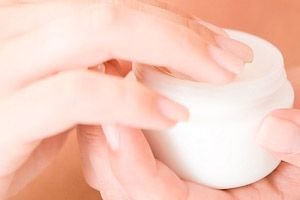
Allergic rashes are a problem known to many. Various medications are used to eliminate them. Let's look at eczema creams, their types and rules of application.
Skin lesions of allergic origin have several forms: acute and chronic. Its causes are varied, these can be external damage (mechanical, thermal, chemical), as well as a number of internal factors (diseases of the gastrointestinal tract, central nervous system, kidneys, liver). Due to the multifactorial nature, the pathological condition very often recurs. In some cases, hereditary predisposition causes exacerbations.
As a rule, the disease occurs due to a decrease in the protective properties of the immune system, the action of constant factors and in the cold season. The rash can be provoked by household chemicals, various detergents, that is, chemical irritants. Depending on the cause, dermatologists distinguish several main types of eczema:
- Atopic
- Professional
- Seborrheic
- Microbial
- Dyshidrotic
- Tylotic
- Sycosiform
In addition, the rash can be wet and dry, but regardless of the type and form, there are symptoms that are characteristic of all cases: vesicular rashes, peeling and burning, severe itching, the formation of painful erosions and cracks. For each specific case, appropriate treatment with the selection of drugs is necessary.
The most effective therapy is considered to be the use of ointments and creams - non-hormonal and hormonal. If the pathology is of an infectious nature, then antiseptic drugs are indicated, in case of fungal infections - antifungal. In addition to local remedies, the treatment consists of a set of measures: physiotherapy procedures, diet, systemic therapy. The use of any drugs must be permitted by the attending physician, who selects effective medications based on the characteristics of the course of the disease.
ATC classification
Pharmachologic effect
Indications eczema creams
Allergic rashes are characterized by the following symptoms: skin itching, peeling, burning, cracks, ulcers, erosions. Indications for the use of eczema cream are based on this symptom complex. The drug is used only as prescribed by a doctor after undergoing a series of diagnostic procedures. Despite the fact that the disease is caused by different factors, therapy in most cases begins with topical drugs.
Any cream must meet the following requirements:
- Provide a comprehensive effect on rashes on different parts of the body
- Eliminate pain, itching, burning, peeling
- Act as a protective barrier, preventing infection with pathogenic microflora
- Moisturize, preventing dryness and cracks in the epidermis
- Have a minimum of side effects and contraindications
It is difficult to independently select a drug that meets such criteria, but a doctor can prescribe the appropriate treatment for each specific case.
 [ 1 ]
[ 1 ]
Release form
Eczema cream has a form of release that assumes its local use. This significantly simplifies the therapy process, since the product can be applied directly to the damaged surfaces. But it will be effective if the approach to the disease is comprehensive.
The choice of medicine depends on the course of the pathological condition. For example, if there are wet wounds on the hands, then in addition to local preparations with corticosteroid hormones, the patient will be prescribed rinsing with disinfecting and drying solutions. If significant erosions appear, then antibacterial drugs are used.
Eczema Cream Names
Treatment of allergic rashes should be comprehensive. Knowing the names of eczema creams and their effects, you can choose an effective remedy. This will eliminate the symptoms of the disease at their first appearance. The medication should have a maximum therapeutic effect on pathological manifestations, relieve inflammation, moisturize and disinfect.
The choice of medicine depends on the cause of the disease and its course. Thus, in case of infectious lesions, antiseptic creams are used, and in case of eczema caused by fungi, antifungal creams are used. If the therapy is ineffective, more serious drugs with hormonal components are prescribed.
Let's look at popular names of eczema creams and their characteristics:
- Bepanten
Accelerates the regeneration of ulcers and wounds, improves tissue trophism. Indicated for external use. Active ingredient: dexpanthenol. The pharmacological action is based on the transformation of the active component into pantothenic acid (part of coenzyme A), which is responsible for healing damage and normalizing cellular metabolism. After application, it is quickly absorbed, binding to blood plasma proteins. It does not metabolize and is excreted unchanged.

- Indications for use: violation of the integrity of the epidermis, daily care, prevention and treatment of dryness, eczema of various etiologies. Care of the mammary glands during pregnancy, care of infants with diaper rash and diaper dermatitis.
- Contraindicated in case of intolerance to the components. Side effects and overdose symptoms occur extremely rarely and manifest as allergic reactions. To eliminate them, you must stop using Bepanten.
- The dosage and duration of treatment depend on the severity of skin lesions. The product is applied in a thin layer to the affected tissues, rubbing in lightly, 1-2 times a day.
- Irikar
A homeopathic remedy that effectively relieves itching and inflammation that may accompany eczema. The active ingredient is the matrix tincture of Cardiospermum halicacabum.
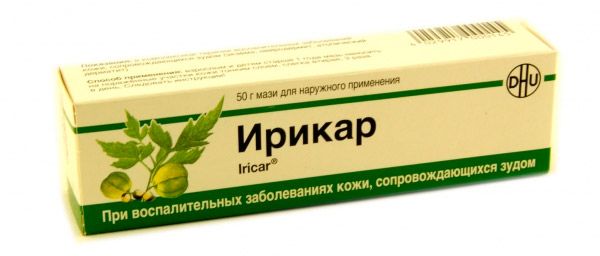
- Used in the complex treatment of dermatological diseases that are accompanied by itching: atopic dermatitis, insect bites, neurodermatitis. Not used in case of hypersensitivity to active substances and other components.
- For adult and child patients, the ointment is recommended to be applied to the skin in a thin layer 3 times a day. Since the drug is well tolerated, its long-term use is permitted.
- Agrosulfan
An antibacterial drug with antimicrobial and wound-healing properties. Due to its analgesic effect, it reduces discomfort and the severity of the inflammatory process.

The active ingredient is sulfathiazole. It is active against gram-positive and gram-negative microorganisms, prevents infection of the wound surface. After application, it is quickly absorbed, part of the active substance enters the systemic bloodstream. It is metabolized in the liver, excreted by the kidneys in the form of metabolites.
- Indications for use: skin damage of various etiologies, burn injuries, frostbite, trophic and purulent wounds, cuts, abrasions, steptoderma, allergic rashes.
- The medicine is intended for external use. It can be applied both to open tissues and under a bandage. Before applying, it is better to clean the wound surface. If the wound is accompanied by exudate, then before using the ointment, it should be treated with a 0.1% solution of chlorhexidine or a solution of boric acid. The product is used 1-3 times a day, the duration of treatment should not exceed 2 months.
- Agrosulfan is well tolerated, side effects occur in isolated cases. Most often, this is irritation and burning at the site of application. Allergic reactions are possible: urticaria, rash, itching. With long-term therapy, adverse reactions from the hematopoietic system and desquamative dermatitis occur.
- Contraindicated for use in case of intolerance to the components, for children under 2 months, during breastfeeding and severe burn injuries with shock.
- Advantan
A pharmaceutical product for external use with the active ingredient methylprednisolone aceponate 0.1%.
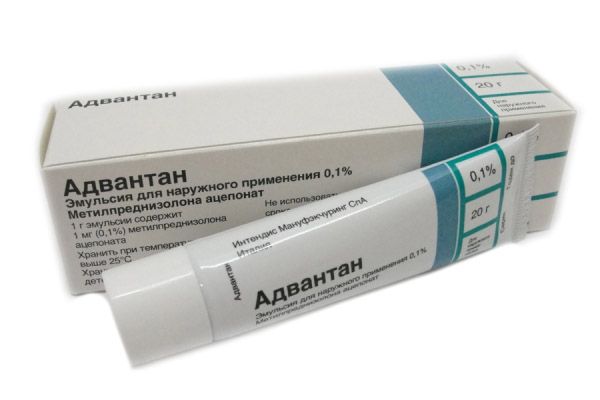
Suppresses allergic reactions and inflammatory manifestations, reduces itching, swelling, and pain.
- Indications for use: acute and subacute eczema without weeping areas. Professional, microbial, dyshidrotic, true eczema. Various dermatitis. To achieve a lasting therapeutic effect, the product is applied once a day to the damaged tissue. The duration of therapy is 12 weeks for adults and up to 4 weeks for children.
- Contraindications: individual intolerance to any component of the drug, viral infections, tuberculosis or syphilis of the skin.
- Side effects most often manifest themselves in the form of itching, burning, hyperemia. Vesicles may appear at the site of application. In rare cases, striae, atrophy, acne, excessive hair growth, folliculitis appear.
- Akriderm Genta
A combination drug with anti-inflammatory, antipruritic, antiallergic and antibacterial properties.
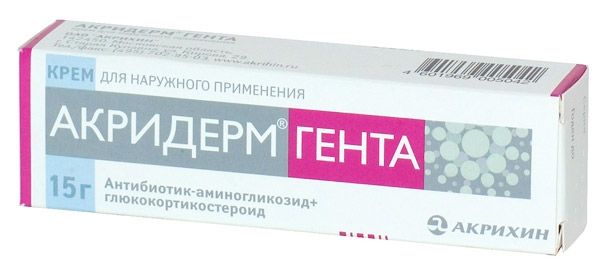
Contains two active ingredients: betamethasone dipropionate and gentamicin sulfate.
- Indications for use: simple and allergic dermatitis, secondary infected dermatitis, neurodermatitis, psoriasis, diaper rash, itching.
- It is intended for external application, but it is necessary to avoid its contact with mucous membranes, skin around the eyes and the scalp. The duration of treatment and dosage is determined by the attending physician. The average duration of therapy is 2-4 weeks, for rashes on the face - no more than 5 days.
- Side effects: local allergic reactions, dryness, perioral dermatitis, acne-like rashes, folliculitis, hypopigmentation. When applied under occlusive dressings, prickly heat, purpura, maceration and atrophy, secondary infection may occur. In case of overdose, hypercorticism and ototoxicity develop. Symptomatic therapy is indicated to eliminate them.
- Contraindications: intolerance to active substances, tuberculosis and syphilis of the skin, reactions after vaccination, perioral dermatitis. Not used for trophic ulcers, for children under 1 year.
- Afloderm
Glucocorticosteroid of synthetic origin. It has antipruritic, anti-inflammatory, anti-allergic and immunosuppressive properties. Its effectiveness is based on the suppression of the synthesis of inflammation mediators and the inhibition of lysosomal enzymes.
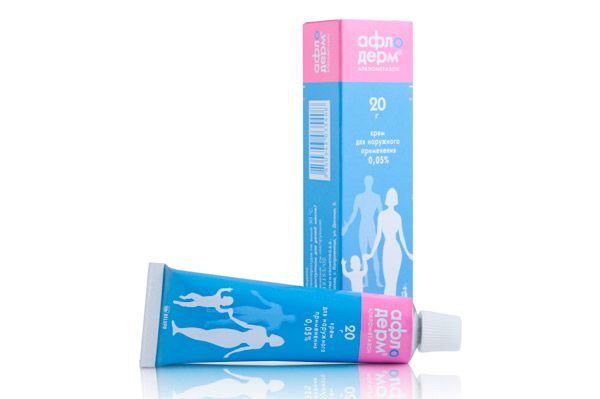
Active components reduce vascular permeability, thereby reducing the risk of blood extravasation. This leads to a reduction in swelling and suppression of the migration of lymphocytes and neutrophils to the site of inflammation.
- Indications for use: eczema of various etiologies, atopic dermatitis, damage from non-ionizing radiation, contact phytodermatitis, allergic reactions, insect bites, psoriasis.
- Afloderm is applied to wounds 2-3 times a day, it can be used under a bandage. It is suitable for treating children over 6 months. The duration of therapy should not exceed 14 days. After application, the product is quickly absorbed, leaving no greasy marks.
- Side effects are rare. Patients may experience a burning sensation, dryness, redness. Atrophic changes in the epidermis, folliculitis, hypertrichosis are possible.
- Contraindicated for use in case of negative reactions to the components of the drug. Not prescribed for patients with syphilis, tuberculosis or herpesvirus skin lesions. Prohibited for trophic disorders, acne, rosacea and for children under 6 months. Allowed to use during pregnancy, provided that small areas of the body are treated.
- Bemilon
Combined medicinal product. Reduces exudation, has anti-edematous, antiproliferative and antiallergic effects.
- Indications for use: allergic and inflammatory dermatoses, eczema, psoriasis, neurodermatitis, erythema, itching of various etiologies, seborrheic dermatitis, lymphocytoma, lichen planus, phlebotoderma.
- Contraindications: skin manifestations of tuberculosis and syphilis, neoplasms, acne vulgaris, rosacea, intolerance to active ingredients and patients under 1 year of age. Use with extreme caution in diabetes mellitus, glaucoma. Not recommended for use in the treatment of rashes in pregnant women.
- The product is applied in a thin layer 2-3 times a day, rubbing into the affected areas, for 5-14 days. In case of overdose, symptoms of hypercorticism are observed. Correction of electrolyte balance is indicated for treatment.
- Side effects: itching, burning, striae, dryness, prickly heat, steroid acne, hypertrichosis. With prolonged use, atrophy, purpura, hypopigmentation, hirsutism are possible.
- Cloveit
Glucocorticosteroid for external use. Active ingredient: clobetasol propionate.
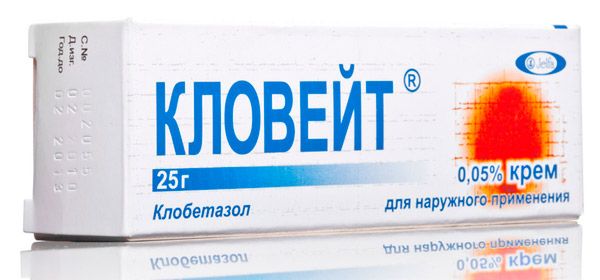
After application to rashes, inflammatory exudation decreases, the intensity of infiltration and granulation decreases. It has antipruritic, antiallergic and anti-inflammatory properties.
- Indications for use: various forms of eczema, epidermal lesions resistant to treatment with less active GCS, lichen planus, psoriasis, discoid lupus erythematosus.
- Contraindications: pregnancy, patients under 1 year of age, hypersensitivity to active substances, rosacea and acne vulgaris, perioral dermatitis, skin manifestations of syphilis and tuberculosis, plaque and pustular psoriasis.
- The method of application and dosage depend on the severity of the rash. Clovate is applied in a thin layer to the wounds 1-2 times a day. In case of overdose, signs of hypercorticism are possible, which requires discontinuing the drug.
- Side effects manifest themselves in the form of dermatological reactions: itching, burning, dryness. Possible weakening of the protective functions of the skin, its atrophic changes, striae, dilation of blood vessels, changes in pigmentation, hypertrichosis. Symptomatic therapy is indicated for treatment.
 [ 2 ], [ 3 ], [ 4 ], [ 5 ], [ 6 ]
[ 2 ], [ 3 ], [ 4 ], [ 5 ], [ 6 ]
Creams for dry eczema
Asteatotic or dry eczema is a common dermatological disease of inflammatory nature. It is characterized by increased dryness of the skin, the appearance of cracks, erosions. The disease has a seasonal focus, most often occurring in the cold season due to low atmospheric humidity. The problem can occur on any part of the body, but most often on the limbs.
Creams for dry eczema help to cope with unpleasant symptoms. Without timely treatment, the rash becomes bright red, eczematous papules appear, which merge into plaques.
As a rule, therapy begins with the systemic use of drugs with fat-soluble vitamins. To prevent the appearance of secondary infection, antibacterial combination agents are used to accelerate the healing of cracks. The selection of suitable drugs is carried out by a doctor.
Let's look at effective creams for dry eczema:
- Radevit
A medicinal product that accelerates tissue regeneration and improves trophism. Contains several active ingredients: α-tocopherol acetate, ergocalciferol and retinol palmitate.

The combined composition provides anti-inflammatory, moisturizing, antipruritic and softening effects. Strengthens the protective functions of the epidermis, normalizes keratinization processes.
- Indications for use: eczema, tissue erosions and cracks, atopic, seborrheic and contact dermatitis, non-infected ulcers and wounds, diffuse neurodermatitis, ichthyosis. Prevention of allergic and inflammatory lesions during remission and after the use of GCS.
- Contraindications: hypervitaminosis A, E, D, hypersensitivity to components, pregnancy and lactation. Side effects are rare. Signs of allergic reactions may appear, i.e. redness and increased itching.
- The medicine is applied in a thin layer to the affected area 2 times a day, preferably in the morning and before bed. In case of increased dryness and peeling, occlusive dressings can be used to limit air access to the wound. When applied to cracks and large wound surfaces, they must be treated with an antiseptic.
- Locoid
A topical corticosteroid with anti-inflammatory, decongestant and antipruritic properties.
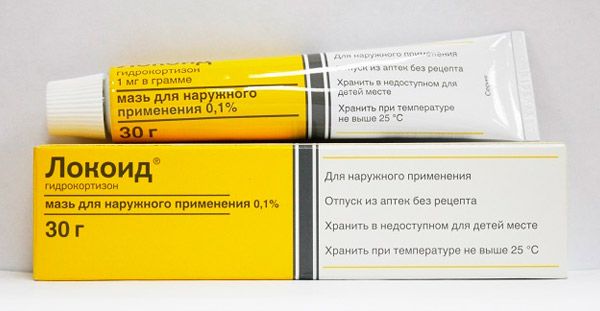
The immunosuppressive effect slows down the division and formation of keratinocytes. Since it contains lipids, it minimizes the penetration of allergens and microorganisms through the skin, reduces water loss, preventing dryness and xerosis.
- Indications for use: allergic rashes, dermatitis, psoriasis. The product is effective in superficial pathological processes that are not accompanied by signs of infection and are sensitive to GCS.
- Lokoid is applied in a thin layer 1-3 times a day, the duration of therapy is individual for each patient. It can be applied to wet wounds and under occlusive dressings. In case of overdose, symptoms of hypercorticism occur.
- Side effects are rare and depend on the duration of treatment. Most often, patients experience signs of irritation, atrophic changes, slow wound healing, depigmentation, and hypertrichosis. When using the drug for 3 months, signs of vascular fragility are observed.
- Contraindicated for use in case of intolerance to components, viral and bacterial lesions of the epidermis, dermatitis, fungal infections, atrophic changes, dermatoses.
- Elidel
Contains the active ingredient pimecrolimus (ascomycin derivative). Has anti-inflammatory properties, prevents skin atrophy.
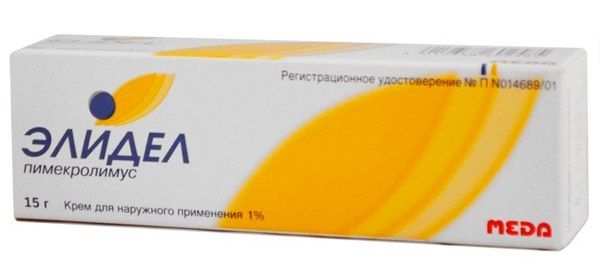
Relieves itching, reduces inflammation, eliminates infiltration, hyperemia, excoriation. Indications for use: increased dryness of the skin and its peeling, atopic dermatitis, rashes.
- The product is used at the first signs of the disease or if atopic dermatitis is suspected. It is rubbed into the affected areas 2 times a day, it can be used in the area of diaper rash. If no positive result is observed within 1.5 months of use, the drug is replaced with more effective ones.
- Side effects: hyperemia, burning, herpetic eruptions, folliculitis, paresthesia, rash, swelling, papillomas.
- Elidel is contraindicated for use in children under 3 months, in case of hypersensitivity to active substances, in pathologies with dysplastic changes and the risk of their malignancy, damage by infectious agents. It is prescribed with special caution to patients with immunodeficiency conditions, with Netherton syndrome and generalized erythroderma.
- Flucinar
Synthetic glucocorticosteroid with the active substance fluocinolone acetonide.
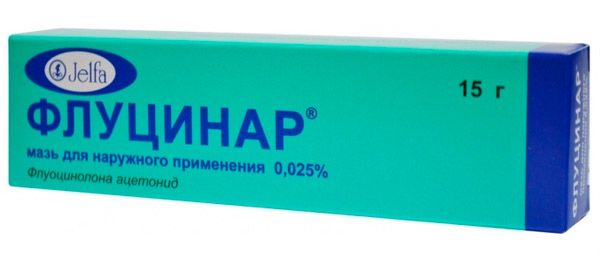
It is well absorbed, has a pronounced anti-inflammatory effect, reduces exudation and proliferation. The anti-allergic effect is based on the reduction of hypersensitivity reactions.
- Indications for use: allergic rashes with increased dryness and contact lesions, seborrheic and atopic dermatitis, acute dermatitis of non-infectious origin, pink and red lichen planus, psoriasis. Contraindicated for use in infections (viral, fungal, bacterial), intolerance to active components and GCS.
- Flucinar is applied in a thin layer to the wound areas 1-3 times a day. The duration of therapy should not exceed 14 days. It is approved for the treatment of children over 2 years old, but is contraindicated for pregnant women.
- Side effects manifest themselves in the form of allergic reactions. Excessive hair growth or loss, thinning of the skin and changes in its color are possible. In case of overdose, signs of hyperglycemia, decreased protective properties of the immune system, and in especially severe cases, Cushing's syndrome appear.
 [ 7 ]
[ 7 ]
Cream for chronic eczema
Skin rashes of allergic origin often take a chronic form. As a rule, this occurs due to self-medication and incorrectly selected drugs. It is difficult to completely cure eczema even with the therapy prescribed by a doctor. This can be explained by the multifactorial nature of the disease. The pathological condition occurs due to the fact that the cells that caused the allergic reaction begin to react to other irritants. This form of the disorder is characterized by skin thickening and roughened areas with cracks, peeling and dryness. Such lesions are localized in places where there is constant contact with the allergen.
Cream for chronic eczema reduces painful symptoms and fights the root cause of the unpleasant condition. For treatment, combined agents are used that are effective against many microorganisms that provoke relapses. At first, the patient is prescribed fatty, dense, potent drugs on a hormonal basis, and later a number of other drugs are connected to restore the epidermis.
Let's look at the main types of topical medications for the treatment of chronic allergic rashes:
- Celestoderm-B
Glucocorticosteroid for external use with the active substance betamethasone valerate.
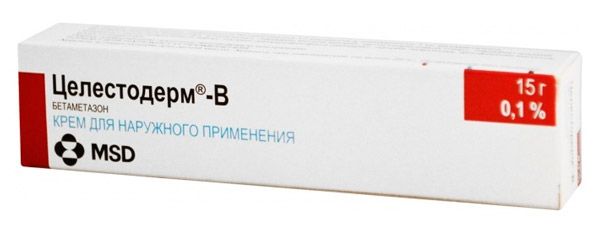
It has anti-inflammatory and anti-allergic properties. Reduces swelling and vascular permeability, improving the protective properties of the epidermis.
- Indications: eczema (dry, chronic, childhood), contact, solar, seborrheic, intertriginous, radiation and exfoliative dermatitis. Also used for psoriasis, anogenital and senile itching.
- Contraindications: intolerance to any of the components, patients under 6 months of age, pregnancy and lactation.
- The product is applied in a thin layer to the wound areas 1-3 times a day. In most cases, to achieve a lasting therapeutic effect, it is sufficient to use 1-2 times a day for 14 days.
- Overdose manifests itself as hypercorticism, Cushing's syndrome, secondary adrenal cortex insufficiency. Treatment is symptomatic, all pathological manifestations are reversible.
- Side effects: burning, irritation, folliculitis, acne, neutral dermatitis, allergic contact dermatitis, secondary infection, striae, skin atrophy.
- Hydrocortisone
GCS, reduces capillary permeability. Has anti-inflammatory, immunosuppressive and antiallergic properties.
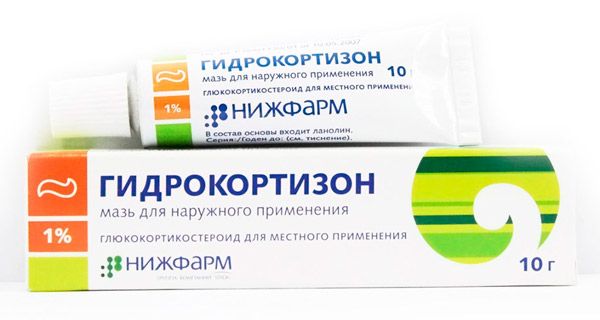
The medicine is prescribed for immediate allergic reactions, various forms of eczema, dermatitis, mycoses, and severe forms of psoriasis.
Contraindications are related to the action of active components and their intolerance. The product is prohibited for bacterial, viral and fungal lesions of the epidermis, for various neoplasms. Not suitable for treating children under 2 years of age. It is applied in a thin layer to the wound surfaces 1-3 times a day.
Hydrocortisone may be used during pregnancy if the potential benefit to the mother outweighs the risk to the fetus. Side effects occur in many organs and systems, but most often these are local allergic reactions. To eliminate them, it is necessary to stop using the ointment.
- Sinaflan
Topical glucocorticosteroid with the active substance fluocinolone acetonide.
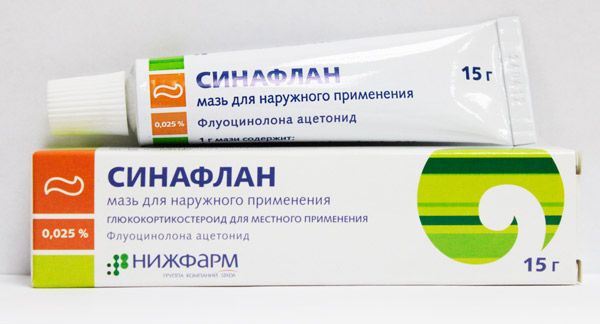
It has anti-inflammatory and anti-allergic properties and promotes vasodilation.
- Indications for use: rashes, psoriasis, lichen planus, neurodermatitis, burns, insect bites. The product is applied to the skin 1-3 times a day, in a thin layer, rubbing in lightly. The duration of therapy is 5-10 days, if necessary, the course of treatment is extended to 25 days.
- Side effects occur with prolonged use of the drug. In this case, signs of skin atrophy and necrosis are observed. When applied to large areas of the body, systemic side effects and adrenal hypofunction may develop.
- Contraindicated for use in case of intolerance to the active substance, infectious lesions of the epidermis, ulcerative lesions, open wounds, during pregnancy and lactation, as well as skin manifestations of syphilis and tuberculosis.
The above-described drugs contain hormones, so they are prescribed to eliminate the chronic form of the disease. They are used for 14 days, applying to the affected areas. If painful and difficult-to-heal cracks appear, then combination drugs are indicated. They include not only hormones, but antibiotics, antimycotics and immunostimulants, let's consider them:
- Triderm
A medicinal product with anti-inflammatory, antibacterial and antifungal properties.

Active ingredients: betamethasone dipropionate, clotrimazole and gentamicin. Due to the combined composition, it effectively relieves itching, swelling and has an anti-exudative effect.
- Indications: rash complicated by infection, dermatoses, allergic and simple dermatitis, neurodermatitis, dermatomycosis, chronic lichen. The medicine is applied in a thin layer to the entire surface of the wound 1-2 times a day. The duration of therapy depends on the localization and size of the pathology. In most cases, a positive effect occurs after 3-4 weeks.
- Contraindications: skin manifestations of syphilis and tuberculosis, patients under 2 years of age, intolerance to active substances, herpes, open wounds, post-vaccination reactions. Triderm should be used with special caution in the first trimester of pregnancy and under occlusive dressings.
- In case of overdose, suppression of adrenal function, Cushing's syndrome and hypercorticism are possible. Side effects are manifested in the form of local reactions: burning, itching, pigmentation disorders, exudation, erythema. Symptomatic therapy is indicated to eliminate them.
- Pimafukort
A combination drug with the active ingredients neomycin, natamycin, and hydrocortisone.
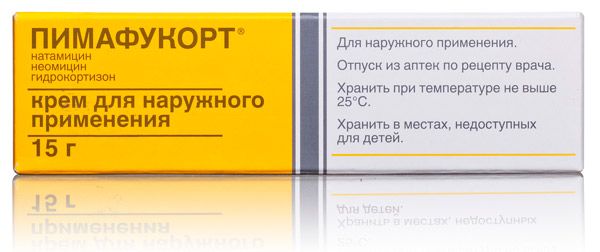
It is used for eczema, mycosis, otomycosis, superficial dermatoses, pyoderma. The product is applied 2-4 times a day for 14-30 days. Contraindicated for children under 1 year of age, allergic reactions to the components of the drug, rosacea, skin manifestations of syphilis and tuberculosis, open wounds, acne, tumors and post-vaccination reactions.
Side effects manifest as an exacerbation of the underlying disease. Withdrawal syndrome is possible after the end of therapy. In rare cases, perioral and rosacea-like dermatitis, atrophy and thinning of the skin, depigmentation occur.
After combination drugs, patients are prescribed non-hormonal drugs that soften, nourish and restore damaged epidermis, for example:
- Emolium
A universal emollient for the care of very dry skin.
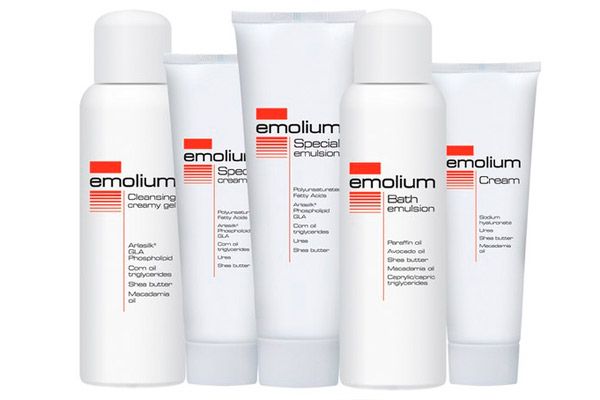
It is used for diseases that are accompanied by increased dryness: eczema, atopic dermatitis, ichthyosis, psoriasis, lichen planus. It is effective both during treatment and prevention. It can be applied to any part of the body, including the face. It relieves itching and burning, hypoallergenic. Allowed for children and pregnant women.
- Atoderm
Strengthens the protective properties of the immune system, prevents the negative effects of external irritants.
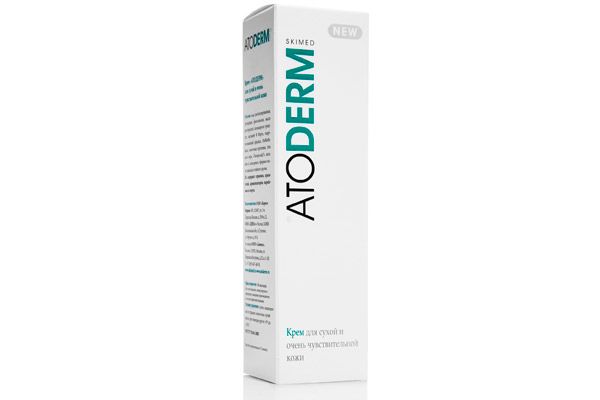
Used to care for dry atopic skin, suitable for patients of all ages. Restores the hydrolipid balance of the stratum corneum, eliminates irritation and flaking. To achieve a lasting therapeutic effect, Atoderm must be used regularly and combined with other products.
- Tricksera
Suitable for eliminating excessive dryness and hypersensitivity to external irritants. Effectively softens, relieves itching, irritation, soothes the skin. Can be used by patients of all ages with any severity of allergic rashes.
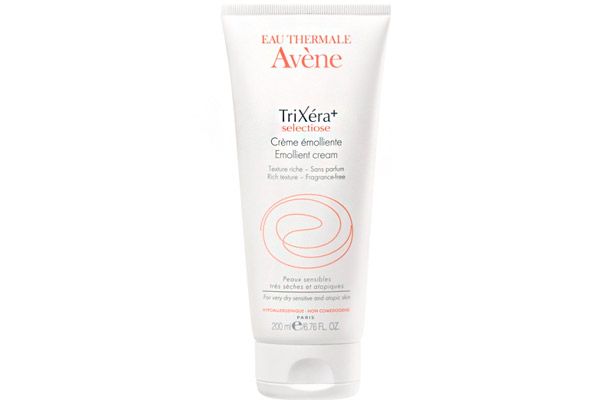
 [ 8 ]
[ 8 ]
Hormonal cream for eczema
For rapid relief of skin inflammation, drugs with hormonal components are used. According to therapeutic action, drugs are classified as follows:
Class I – have a weak effect, are suitable for treating pregnant and lactating women, as well as for children under 2 years of age.
- Prednisolone
A medicinal product for local use with the active ingredient prednisolone.
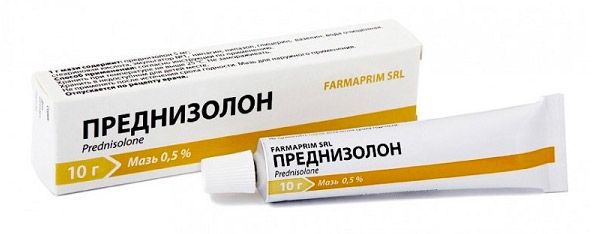
It has a pronounced anti-inflammatory, anti-exudative and anti-allergic effect. After its application, the active substance is quickly absorbed and penetrates into the systemic bloodstream. Biotransformation occurs through oxidation in the liver, excreted as metabolites in urine and feces. Penetrates the placental barrier, is found in breast milk.
- Indications for use: non-microbial epidermal lesions, eczema (dry, weeping), dermatitis, itching, complete or partial hair loss. The drug is applied to wound surfaces 1-3 times a day. The duration of therapy is 8-14 days in adults and 3-7 days in children. It is prohibited to use fixing, occlusive and warming bandages.
- Side effects: burning, erythema, itching, folliculitis, perioral dermatitis, hypertrichosis. The above symptoms do not require treatment, as they disappear after discontinuation of the drug.
- Contraindications: intolerance to components, syphilis and tuberculosis of the skin, chickenpox, shingles, diseases of viral etiology, fungal and bacterial infections, tumors, pregnancy and lactation.
- Fluocinolone acetonide
GCS with anti-inflammatory, antipruritic, antiallergic and antiexudative properties.
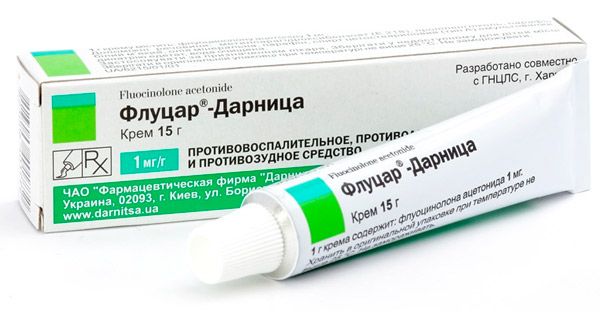
- Indications for use: neurodermatitis, skin itching, lichen planus, psoriasis, perianal and vaginal itching. The medicine is applied to the affected area 2-3 times a day, lightly rubbing into the skin. The duration of therapy depends on the severity of the disease and usually lasts 5-10 days. If necessary, it is extended to 25 days.
- Side effects: thinning and atrophic changes in the skin; when applied to large areas, systemic side effects characteristic of GCS may occur.
- Contraindications: infectious lesions, syphilis and tuberculosis of the skin, various neoplasms. With special caution, prescribe for children under 1 year and for adolescents during puberty.
Class II – used when weaker drugs have proven ineffective. Excellent at stopping severe inflammation.
- Cinacort
Glucocorticosteroid with the active substance triamcinolone. After application to rashes, it has an antiallergic, anti-inflammatory and antiexudative effect. The active component suppresses inflammatory reactions in response to immune, mechanical or chemical damage.
- Indications: eczema, dermatitis (simple, allergic, atopic), neurodermatitis, toxicoderma, psoriasis, lichen planus, alopecia areata, insect bites. The product is rubbed into the skin 2-3 times a day, the course of treatment is 5-25 days, depending on the severity of the pathological symptoms.
- Contraindications: intolerance to active components, pregnancy and lactation, viral, fungal and bacterial lesions of the epidermis.
- Side effects: itching, irritation, steroid acne, atrophic changes, purpura.
Class III – used to treat chronic eczema.
- Sinalar
A combination drug with the active ingredients fluocinolone acetonide and clioquinol.
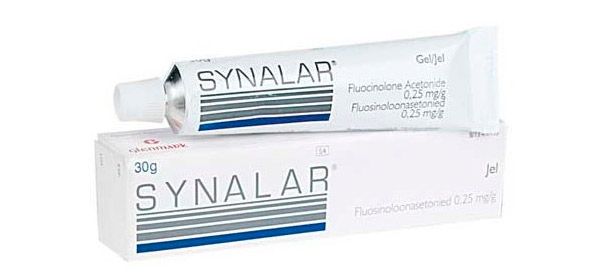
It has antibacterial, antiallergic, anti-inflammatory and antipruritic effects. Prevents the release of exudate from small tissue vessels.
- Indications for use: eczema (dry, weeping), seborrhea, dermatitis, secondary bacterial infection, mycosis, diaper rash. To achieve a therapeutic effect, a small amount of cream is applied to the wound surface 2-3 times a day and rubbed in thoroughly. If occlusive dressings are used, the wounds are pre-cleaned.
- Contraindications: fungal, viral and bacterial infections, rosacea, perianal and perioral dermatitis. Not prescribed for children under 1 year of age, during pregnancy and lactation, extensive psoriasis plaques.
- Side effects: local allergic reactions, irritation, striae, atrophy and thinning of the skin, local dilation of small vessels, systemic reactions due to suppression of adrenal function.
- Apulein
A pharmaceutical product on a vaseline base with the active substance - budesonide. Non-halogenated glucocorticosteroid effectively normalizes vascular permeability, has vasoconstrictive properties, inhibits cell migration into the inflamed epidermis. It is used to treat chronic eczema, psoriasis, atopic dermatitis. It is applied 1-3 times a day, the course of treatment is 21-28 days.
It has a number of contraindications: hypersensitivity to active substances, viral, fungal and bacterial infections, perioral dermatitis, pregnancy and lactation. Side effects are manifested as atrophy, folliculitis, striae, burning, itching.
Class IV – drugs of this group are prescribed in limited cases. When other medications have not given the desired result. They penetrate deep into the skin, providing the highest therapeutic effect.
- Halcinonide
A topical glucocorticoid. It is prescribed for non-infectious inflammatory skin diseases. It is applied in a thin layer to the affected areas 1-3 times a day. It can be used under a bandage. The duration of therapy is individual for each patient. It is not used to treat pregnant women and children.
Hormonal cream for eczema is used only for specific medical indications. This is due to the fact that this pharmacological group has many contraindications and side effects. The duration of therapy is strictly limited, and the drug should be discontinued gradually with a decrease in dosage.
Non-hormonal cream for eczema
The choice of a drug for treating dermatological problems depends on how severe the inflammation is and how far it has spread. Non-hormonal eczema cream is rightfully considered the safest topical remedy that can be used for a long period of time. It is not addictive, has a minimum of side effects and contraindications. But its effectiveness is weaker than hormonal, so it is prescribed in the early stages of the disease or when treatment with other types of drugs is impossible.
Non-hormonal and auxiliary drugs have no restrictions on the scope of application. That is, a product with the same active components can be applied to the skin of the hands, body and face. But do not forget that any medication is used only as prescribed by a doctor. The doctor assesses the patient's condition, the severity of allergic rashes and the risk of developing side effects.
Let's look at popular medications from this pharmacological group:
- Eplan
An external agent with bactericidal, wound-healing and regeneration-accelerating properties. The active ingredients relieve pain and have an anti-inflammatory effect. Provides comprehensive tissue protection from the effects of negative factors of various origins.
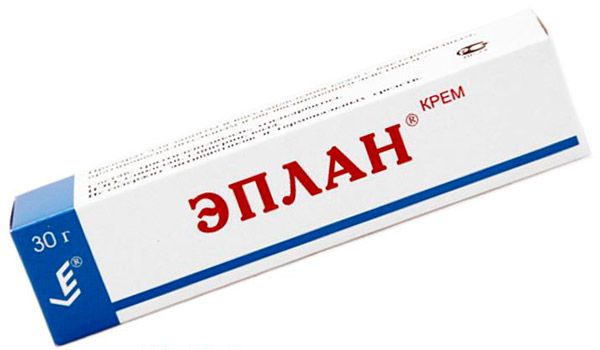
Main indications for use: eczema (especially microbial), psoriasis, burns, itching and swelling from insect bites, bedsores, acne vulgaris, ulcers. Eplan is applied to the skin in a thin layer 1-3 times a day, the duration of treatment is 5-21 days. Contraindicated in case of intolerance to its components. Side effects are manifested in the form of local irritation.
- Pantoderm
A medicinal product with the active ingredient dexpanthenol.
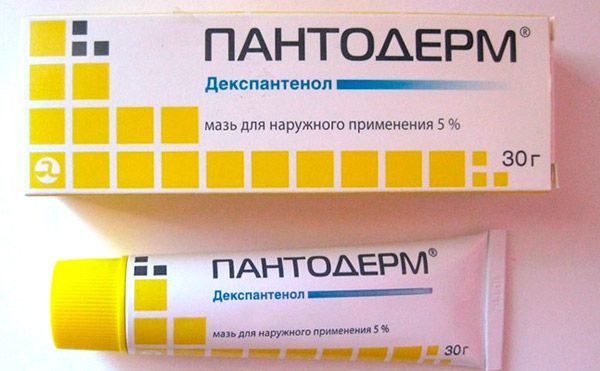
After application, the active components are transformed into pantothenic acid, accelerating the regeneration processes.
- Indications for use: increased dryness of the skin, cracks, erosions, bedsores, minor epidermal lesions of any etiology, diaper rash, furuncles, trophic ulcers of the shin, skin irritation, abscesses. The ointment is applied to the skin 1-2 times a day, the duration of therapy depends on the therapeutic effect in the first days of using the product. Pantoderm is allowed during pregnancy and lactation, for pediatric patients.
- Side effects: urticaria, itching, vesicular rash, mild irritation, erythematous spots. Since there is no systemic absorption of the drug, overdose is impossible.
- The main contraindication is associated with individual intolerance to dexpanthenol and other auxiliary components.
- Panthenol
Cream for improving trophism and tissue regeneration. It is used in case of damage to the integrity of the skin, rashes, dermatitis, cracks, ulcerative lesions, various inflammatory pathologies (boils, trophic ulcers). It is suitable as a preventive measure in case of adverse effects of environmental factors on the epidermis.

It is applied in a thin layer to the damage, rubbing it in lightly. The procedure should be carried out 2-4 times a day for 10-14 days. Side effects appear as minor allergic reactions at the site of application. Panthenol is contraindicated in case of hypersensitivity to its active ingredients.
- Losterin
Dermatological product for complex therapy of chronic skin diseases and daily care. It has a combined composition: dexpanthenol, urea, salicylic acid, natural oils and herbal extracts. Losterin has antipruritic, anti-inflammatory, exfoliating properties. Improves skin barrier functions and accelerates the regeneration process.
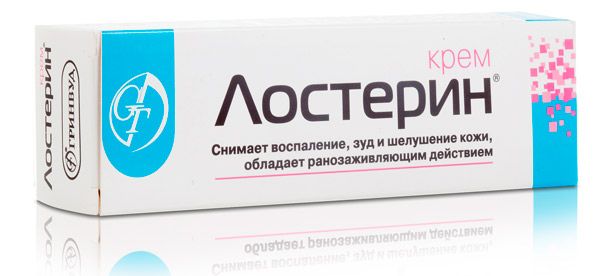
Indications for use: various forms of eczema, dermatitis and dermatoses, severe dry skin, psoriasis, seborrheic dermatitis, xerosis, ichthyosis, lichen planus. Can be used to prevent skin pathologies and as a care product. Approved for pregnant women and children from 3 months of age. It is applied in a thin layer to the affected areas 2-3 times a day. Duration of treatment is 15-30 days. The main contraindication is intolerance to the components of the drug. No side effects or cases of overdose have been recorded.
Eczema Cream for Children
Treatment of dermatological diseases in pediatric patients has a number of difficulties. This is due to the fact that not all drugs can be used. Cream for eczema for children on a natural basis is the safest option for therapy. This is due to the fact that hormonal drugs and drugs with a combined composition are very often contraindicated for children and cause many side effects.
To achieve and maintain good treatment results, effective but also safe local remedies are needed that can be used over a long period of time. These include such drugs as:
- Skin-cap
Antiproliferative, antibacterial and antifungal agent for external use. The active substance is zinc pyrithione activated. After application to the wound surface, it penetrates the epidermis and superficial layers of the dermis.
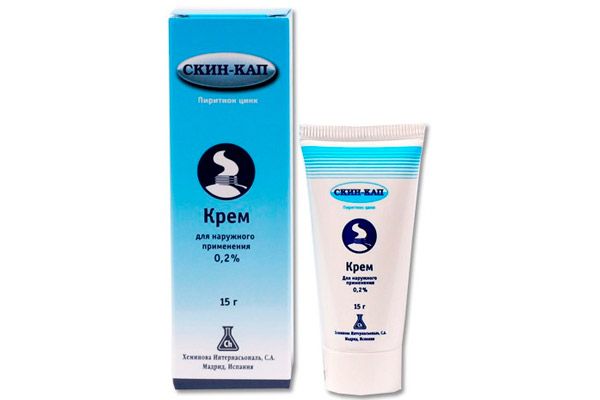
It is used to treat dry and chronic eczema, dermatitis, psoriasis. Contraindicated in case of intolerance to the active component. It is applied in a thin layer to the lesions, rubbing in lightly. The procedure is carried out 2 times a day for 3-4 weeks. It can be used during pregnancy and lactation, as well as for pediatric patients. Side effects are rare and manifest as local irritation.
- Likanshuan
A preparation based on natural plant ingredients. Does not contain antibiotics and hormones. Ideal for treating children, pregnant women and patients with intolerance to GCS.
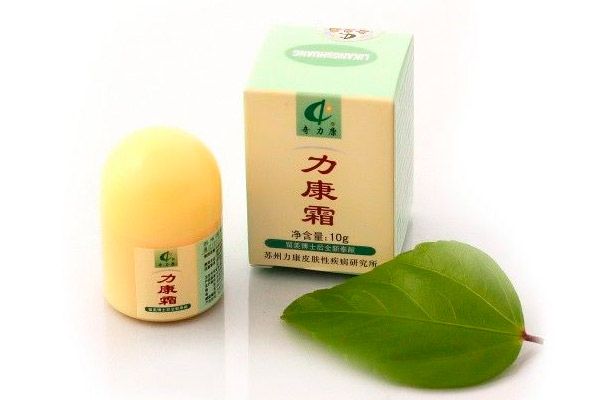
The medicine is used 2-3 times a day, applying a thin layer to the wounds. The duration of therapy depends on the severity of the pathological process and the doctor's recommendations.
- Canison Plus
Anti-inflammatory, anti-allergic, antibacterial and antifungal agent with the active substance - betamethasone dipropionate. It is prescribed for children over 2 years old. Helps in the treatment of eczema, dermatitis, dermatomycosis, simple chronic lichen. Not used during pregnancy, with skin post-vaccination reactions, manifestations of syphilis and tuberculosis, open wounds and chickenpox.
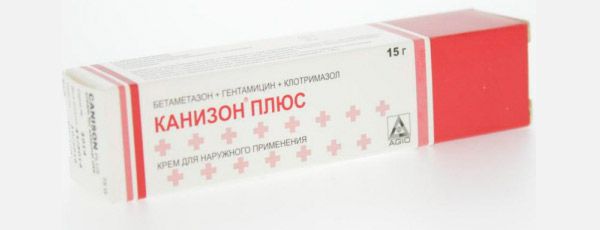
The product is applied in a thin layer to the entire surface of the wound area, capturing healthy tissues 2 times a day. The duration of therapy is 3-4 weeks. Overdose manifests itself as Cushing's syndrome and hypercorticism. Symptomatic therapy is indicated to eliminate them. Side effects are rare, patients may experience mild burning, pigmentation disorders, itching.
- Thymogen
Synthetic dipeptide with immunostimulating properties. Approved for children over 6 months, as well as during pregnancy and lactation. Used for the treatment and prevention of acute and chronic infectious diseases and immunodeficiency.
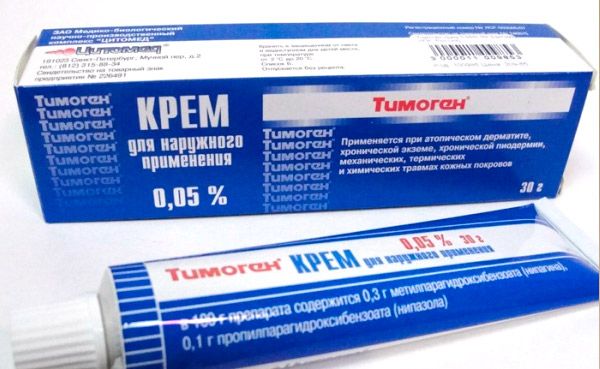
Accelerates the regeneration process and accelerates healing after weeping eczema. The dosage is individual for each patient, therefore it is determined by the doctor. The course of treatment is 3-10 days. Side effects and symptoms of overdose are local allergic reactions.
- We see
Vitamin remedy for local use. Active ingredient – retinol, a fat-soluble vitamin. Used to treat allergic rashes, psoriasis, dermatitis and other pathological processes of the skin. Not used in the first trimester of pregnancy and in case of hypersensitivity to the components.
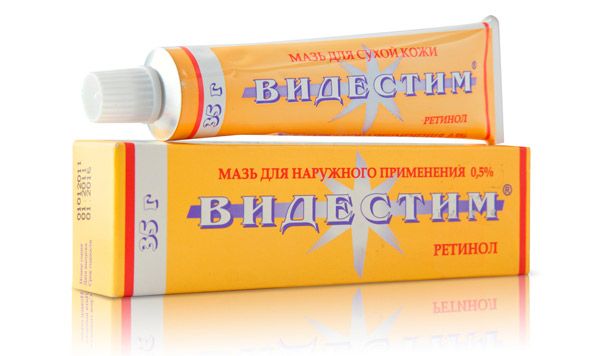
Videstim is applied in a thin layer to the wounds 3-5 times a day, the course of treatment is up to 14 days. With prolonged use, adverse reactions may occur: hyperemia, rashes. Symptomatic therapy is indicated to eliminate them.
- Desitin
The drug with the active substance - zinc oxide. It has anti-inflammatory, antiseptic properties. After application to the skin, it helps reduce the inflammatory reaction. Forms a protective film, minimizing the negative impact of environmental factors. Softens dry epidermis and accelerates the healing of weeping wounds. It is not absorbed into the systemic bloodstream and does not have a systemic effect.

Indications for use: skin lesions of various etiologies, acute eczema, steptoderma, ulcers, dermatitis, bedsores. The cream is applied to dry, clean skin 2-3 times a day, the duration of therapy depends on the results in the first days of treatment. Desitin is contraindicated in case of intolerance to its components. Side effects are manifested in the form of local allergic reactions.
Pharmacodynamics
The physiological action of a drug and its biochemical reactions are pharmacodynamics. Let's consider this using the example of a glucocorticosteroid - Dermovate. The active substance is clobetasol propionate, it reduces the process of exudation and accumulation of neutrophils, reduces the intensity of granulation and infiltration. It has a local anti-inflammatory, antiallergic, antipruritic and antiexudative effect.
GCS is prescribed for adult patients and children over 1 year of age. It relieves symptoms of inflammation and itching, accelerates skin healing in various forms of eczema, psoriasis, dermatoses and lichen planus. It is used only as prescribed by a doctor.
Pharmacokinetics
After application to the skin, Dermovate undergoes systemic absorption with intact healthy epidermis. Pharmacokinetics indicate a high level of absorption, which is determined by the integrity of the epidermal barrier. The inflammatory process in the acute stage or occlusion increases transdermal absorption.
Metabolism occurs via pharmacokinetic pathways typical for systemic glucocorticosteroids, i.e. in the liver. It is excreted as metabolites in urine and feces.
Dosing and administration
In order for the treatment of a dermatological disease to be quick and as effective as possible, patients are prescribed external agents. The method of application of eczema cream, its dosage and duration of therapy depend on the severity and extent of the pathological process.
The cream is applied in a thin layer to cleansed skin, rubbing it in lightly. Treatment procedures are carried out 1-4 times a day, depending on the type of drug and its composition. As a rule, a positive result is observed after 3 days. The course of treatment can last from several days to several months. But if the skin condition does not improve after the prescribed period of use of the drug, then you should consult a doctor, review the diagnosis and the therapy.
Use eczema creams during pregnancy
Treatment of dermatological diseases in expectant mothers is carried out under strict medical supervision. That is, the use of cream for eczema during pregnancy is possible after a series of diagnostic procedures and tests prescribed by the doctor. This will allow you to choose the most effective and safe remedy.
Hormonal drugs and many combined medications are prohibited. This is due to the fact that their active ingredients can negatively affect the health of the woman and the fetus. Their use is possible when the potential benefit to the mother is higher than the risks to the child. As a rule, pregnant women are prescribed safe non-hormonal drugs and medications on a natural plant basis.
Contraindications
Any pharmaceutical product has contraindications for use. Let's consider the main ones, using eczema cream as an example:
- Individual intolerance to the components of the drug
- Skin manifestations of syphilis and tuberculosis
- Rosacea
- Acne
- Skin neoplasms
- Bacterial, viral and fungal infections (with GCS treatment)
- Perianal and genital itching
- Pregnancy and lactation, infancy and childhood of patients (hormonal and combination creams)
In order for treatment to be as effective and safe as possible, it is very important to follow your doctor’s recommendations and use medications only as prescribed.
Side effects eczema creams
Undesirable symptoms from topical medications for the treatment of dermatological diseases occur when they are used incorrectly. Side effects of eczema cream most often manifest as local allergic reactions. That is, patients experience hyperemia, rashes and itching, which stop after discontinuing the drug.
Thinning and atrophy of the skin, increased dryness, hypertrichosis, and worsening of the symptoms of the underlying disease are also possible. When applying the drug to large areas of tissue, systemic side effects may be observed. In this case, a doctor's consultation is required.
 [ 23 ]
[ 23 ]
Overdose
With prolonged use of the drug or failure to comply with the recommended dosage, adverse reactions occur. Overdose manifests itself in the form of local symptoms. This is due to the fact that topical medications have a low level of absorption, so they do not cause systemic effects. Patients experience itching and burning, redness, rash and other reactions similar to the underlying disease.
To treat an overdose, stop using the cream and go to the hospital. When using hormonal drugs or GCS, the dosage should be gradually reduced to prevent withdrawal syndrome and a number of side effects.
Interactions with other drugs
A comprehensive approach to treating any disease is the key to a quick recovery. Interactions with other drugs are controlled by the attending physician. Thus, it is contraindicated to apply several drugs to one wound area. This can provoke side effects that will only worsen the symptoms of eczema.
Storage conditions
Compliance with the doctor's instructions and storage conditions of the medicine allows achieving effective treatment results. It is recommended to keep topical preparations out of the reach of children, in a cool place protected from sunlight. The storage temperature should not exceed 30°C. Ignoring these instructions leads to spoilage of the medicine and loss of its pharmacological properties.
Shelf life
Eczema cream, like any other drug, has an expiration date. It is indicated on the packaging or tube of the product. As a rule, it is 12-36 months, subject to storage rules. The use of expired drugs can cause uncontrolled side effects.
 [ 39 ]
[ 39 ]
Attention!
To simplify the perception of information, this instruction for use of the drug "Eczema creams" translated and presented in a special form on the basis of the official instructions for medical use of the drug. Before use read the annotation that came directly to medicines.
Description provided for informational purposes and is not a guide to self-healing. The need for this drug, the purpose of the treatment regimen, methods and dose of the drug is determined solely by the attending physician. Self-medication is dangerous for your health.

